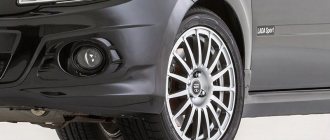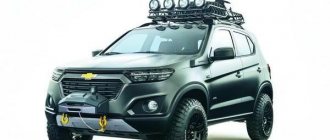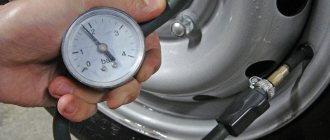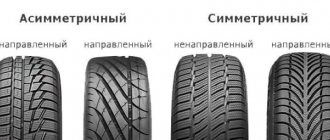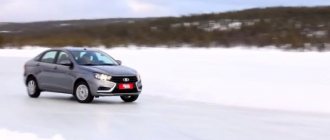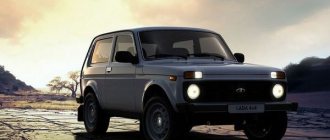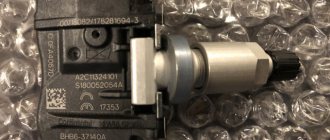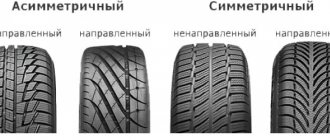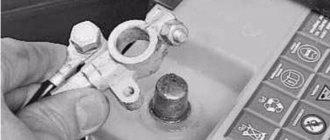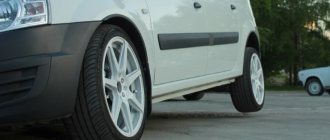05 December 2014 Lada.Online 122 820 8
An experienced driver knows how important it is to periodically check the pressure in your car's tires. If the pressure does not correspond to the recommended one, this leads to accelerated tire wear, as well as a deterioration in the stability and controllability of the vehicle. The table shows the recommended tire pressure for the Lada Granta.
What does air pressure in tires affect?
The pressure in car tires determines the level of driving comfort and safety, and also contributes to the durability of the working units and components of the car.
Low pressure in Lada Granta tires increases heating during rolling and contributes to wear of the tread tracks located along the edges. The integrity of the frame may even be compromised. Fuel consumption also increases. If you hit a pothole, the risk of damage to your rim or tire is much higher.
Tire pressure "Lada Grants"
Increased tire pressure on the Lada Granta overstrains the cord threads and wears out the middle section of the tread. In addition, when driving on a bad road, the shocks transmitted to the suspension and body will be more clearly felt by passengers. Of course, the suspension will also wear out more. And if you drive into a pit, the risk of a tire rupture increases.
Different pressure for all four wheels also has its drawback: in this situation, when braking, the car is guaranteed to be pulled to the side by the wheels with minimal pressure, and the car will actually start moving sideways.
Tire life
Reduced tire pressure on the Lada Granta increases tire abrasion at the edges.
Increased - also affects the service life of tires. In this case, the tension in the carcass threads increases: as a result, the cord breaks down noticeably faster. In this case, the tire interacts with the road through the middle section of the tread, which provokes its rapid wear.
Compliance with the recommended pressure allows you to evenly distribute the load and increase the tire life.
Machine controllability
The pressure of a specific value in the Lada Granta wheels is indicated for a reason. Although its reduced performance at low speeds does not particularly affect the car’s behavior, at speeds of 60 km/h or more, underinflated tires significantly worsen handling and increase braking distance.
A car with increased pressure in the tires on a dry road surface is somewhat better in handling, however, strong overinflation of the wheels leads to the fact that any sudden maneuver guarantees a skid (especially on a wet road), or even a complete loss of control.
With reduced pressure in the Granta wheels, the car’s ability to turn also changes. for example, a rear-wheel drive car with lowered front tires will have a harder time turning.
The inflation of the front wheels of a front-wheel drive car must always be normal, since its reduced level provokes skidding in an emergency situation.
P14 wheels on Grant
Patency
Even the owner of an ordinary four-wheel drive car, for example a sedan, can independently provide it with tolerable cross-country ability. To do this, just let some air out of the wheels, and they will not sag in sand, snow or mud. To even get out of a “black spot”, you just need to lower the pressure to 1.2 bar.
In a particularly difficult situation, if your wheels have a narrowed rim and a fairly wide tire (in this combination there is a lower risk of self-disassembly), the indicator can be increased to 1.0 bar.
Stability on slippery roads
A wet track always carries danger. But if you increase the pressure in the Lada Granta tires, reducing the contact patch of the rubber with the track, the risk of aquaplaning will also decrease. This will also improve handling and optimize fuel consumption. However, you need to know when to stop, as this option has its own disadvantage: an increased risk of a tire explosion.
If the car slips on wet grass, then, on the contrary, relieve the pressure.
Braking efficiency
The higher the pressure in the Grant R14 wheels, the less grip they have on the road. Consequently, the longer the braking distance: as the atmosphere decreases, it will decrease, but at the expense of reduced directional stability.
Car modifications
Lada Kalina was produced for 14 years. The manufacturer offered the consumer two generations of small class cars.
Tire pressure
First generation
The debut car of the Kalina family appeared at AvtoVAZ in 2004. It was released as a sedan. The first generation cars were equipped with 1.4 liter (89 hp) and 1.6 liter (81 and 98 hp) petrol engines. In 2006, Kalina hatchbacks appeared, the next year - station wagons, and a year later - a sports modification. Depending on the configuration, the car was equipped with ABS, electronic power steering, airbags, and an air conditioning system. During production, changes were constantly made to the equipment of the vehicle. In 2009 and 2011, Lada Kalina became one of the best-selling brands in the country.
Second generation
In 2013, the plant's conveyor belt was modernized to begin production of the next generation of cars. LADA Kalina 2 was produced in hatchback and station wagon bodies. It is characterized by a more modern appearance, better aerodynamics and increased comfort. Improved powertrain, suspension and gearbox are distinctive features of the vehicle compared to previous generation models. Both hatchbacks and station wagons were equipped with 1.6 liter engines with variable intake, the power of which varied between 87...106 hp. A manual or automatic transmission was installed.
The maximum configuration included the installation of anti-lock systems, stability control, air conditioning and navigation, a traction control module, an after-braking system, a passenger airbag, a touch screen, heated front seats, a rain sensor, etc.
The latest modification of the Kalina family is the Lada Kalina Cross. It is distinguished by increased ground clearance, a modified final drive ratio and a more aesthetic appearance, for example, due to decorative trims on the wheel arches and sills.
In 2021, the production of Kalina family cars was discontinued.
What should be the pressure in Grant tires under different conditions?
For every 10 degree change in temperature, the air pressure in the tire also changes by 0.1 bar. So, if in summer the indicator should be 1.9-2.0 atmospheres, then in winter or at full load it reaches 2.1-2.2, and cars with summer tires in April, they can only be pumped up occasionally until the beginning of September. But the winter one will have to be checked regularly after the next frost.
In summer
In the summer, during extreme heat, the pressure in the p14 wheels on the Grant increases slightly due to the heating of the air in the tires. So you don’t have to pump them up, plus or minus 0.3 atm.
in winter
In winter, the air is compressed, which is why the tires need to be pumped to the same 0.3 atmospheres: even if in a warm garage the pressure gauge shows the desired value, on the street the value will drop by at least 0.3 bar, and you will find yourself with underinflated tires.
Installing a pressure gauge to check tire pressure
For a relaxing ride
In Lada Granta wheels, the pressure should be standard for quiet driving, that is, recommended. Car manufacturers place the “cheat sheet” on the gas tank cap, the middle pillar or on the driver’s side door. As a rule, you can use tires of different sizes, and the required value for them is not always the same.
For racing
In motorsports, everything is determined by the contact patch of the tire. By increasing or decreasing it, it is easy to change the handling of the sports car.
By reducing the pressure in the wheels of the Lada Granta liftback, we increase the contact area. If you increase the pressure, the car then responds better to the steering impulse, and straight line acceleration increases due to reduced rolling resistance.
But the traction properties of the tire will also become less: overinflated wheels seem to stand on tiptoes. So, depending on the requirements of your type of motorsport, you need to find a compromise so that the tires have enough grip during acceleration and braking, but do not deform when cornering due to low inflation.
For long trips
When traveling long distances, it is recommended to lower the tire pressure by 0.1 atmospheres. Long driving easily compensates for this decrease by heating the air, which expands as a result.
For driving in mud
When you find yourself on a muddy dirt road, it is better to lower the wheels: the contact area will increase, the ride will become more comfortable, and the suspension will not wear out.
For driving in open mud, it is better to reduce the pressure to 1 bar. Just remember that in this case you should not accelerate over 30 km/h. Otherwise you risk losing control. It is also undesirable to let the tires go down too much before descending a steep slope, since during braking the tires will rotate independently even after the wheel rims are locked.
For driving on snow and ice
If ice catches you by surprise, it is better to lower your wheels to 1.5 atm. Tire wear will, of course, increase, but cross-country ability will also increase significantly. However, in this case, any high speed is unlikely, and overheating of the rubber at low temperatures most likely will not occur.
Forcing deep snow also means reducing pressure: this way you will noticeably increase the contact area, and, on the contrary, minimize the pressure on the snow.
The main thing is not to overdo it. To avoid getting stuck in the snow, it is recommended to inflate tires to 0.8–1 atm. But if you have low-profile ones, it is better not to drop below 1.2 atm.
"Lada Granta"
Please note that even a short trip on lowered wheels heats up the air in them and increases the pressure.
For transportation of goods
It is advisable to take into account the manufacturer's advice on tire pressure when fully loaded. At a minimum, you should inflate the wheels at least at the rear by 0.2–0.3 bar.
185/65R15
Kumho KH27 Ecowing ES01
These are Korean tires from a prestigious brand, but in the budget segment. Good acceleration, maneuvering and braking are guaranteed due to the symmetrical tread, both on dry and wet asphalt.
Even in the case of significant wear, the tires effectively prevent hydroplaning. Uniform abrasion is ensured by the wide and flat design.
Longitudinal blocks in the projector, along with interspersed deep grooves, improve handling and enhance ride comfort. And background noise is reduced by thoughtful placement of ribs and blocks. Price – 2,600 rub.
How to determine tire pressure
Tires should be checked regularly: before a trip or once a week. Measure the pressure when the tires are cold, that is, several hours (4-5) after stopping the car. If pumping is required on the way, it is better to make it 10% more than normal. Verification can be carried out in different ways, which we will discuss further.
Compressor
A compressor is a special machine for inflating tires. Connect it to the mains and watch the built-in pressure gauge. When the pressure rises to the desired level, the device will simply turn off.
Pressure gauge
Using the pressure gauge is extremely simple:
- You need to remove the cap on a car tire.
- Apply the pressure gauge to the valve for a few seconds.
- Compare the performance of all four tires and, if necessary, inflate.
The entire procedure takes a maximum of a few minutes.
Sensors
The sensors convert the pressure information received from the wheel controllers into an electrical signal and transmit it to the transceiver via Bluetooth. A special program processes this data and, if necessary, signals the driver. Some systems send a message to a smartphone.
You can set the limit values of operating parameters yourself: adjustment is available from 1.7 to 3.2 bar.
Visually
It is better to carry out an inspection before each trip: at least just to see if there are any flat tires. But it is not possible to determine the pressure “by eye”: even 10 PSI and 20 PSI are practically indistinguishable in this way.
Handheld portable pressure gauge for checking tire pressure
Only a high-quality pressure gauge guarantees you an accurate result.
A short checklist - How to buy tires for the Lada Granta correctly
1. You should look for the right tires, keeping in mind the factory dimensional specifications. The size of the selected tires must match these data. 2. Pay attention to the tread pattern. Driving comfort largely depends on it.
3. Pay attention to the width parameters. The acceleration and braking of a car is affected by the width of the spot converging with the road surface. 4. Particular attention should be paid to the bore diameter. Tires that are excessively high or wide can damage the suspension, while tires that are too narrow will increase the load on the bearings. 5. It is important to consider the maximum speed index and load capacity index. 6. Treadwear, Traction, Temperature and MaxPressure data provide information on the tire's factory wear life, braking performance, temperature resistance and pressure limit for the tire respectively.
Is it possible to drive on flat tires?
Driving with flat tires is, of course, possible, but it is fraught with consequences.
This results:
- to wipe the side protectors;
- excessive heating of rubber and its accelerated deterioration;
- deterioration of vehicle controllability, especially when cornering;
- excessively high fuel consumption.
The only advantages of underinflated tires are a soft ride, and also the fact that there is no noise or rattling. However, the disadvantages of such use clearly outweigh the advantages.
Is it possible to drive on overinflated tires?
Of course, you can ride with such tires, but if you do it too often, you cannot avoid the consequences:
- the suspension quickly fails;
- the middle section of the tread is wiped off;
- The interior rattles, and you can especially feel the bumps on the road.
The only plus is fuel economy.
Winter tires for Lada Granta
The selection of winter tires for the Lada Granta should be based on the characteristics of the terrain on which you will have to drive. If the roads are not cleared enough, and the winter threatens frequent thaws followed by frosts, then in this case you should use studded tires.
Tires for winter use must have soft contact with the road surface, which will provide a reliable degree of traction even on packed snow, and the tread base must be rigid for precise steering. Goodyear, Pirelli and Dinlop Winter companies have the necessary dimensional characteristics for the Lada Granta, namely in the range from R13 to R16.
Winter tires will also require running-in to ensure they fit firmly in their seats. For a good break-in, you will need to drive about 500 kilometers. When running in, you should try to avoid sudden braking and slipping. To improve traction, it is also recommended to choose tires with a narrow profile.
Source
How to pump up tires
You need to pump up the Lada Granta wheels according to the following scheme:
- Find out the recommended pressure.
- Check the level in the wheel.
- If the indicator is more than necessary, bleed off the excess: use a fingernail or something pointed to press the central pin of the nipple.
- If the indicator is less than required, then inflate the tire with a pump or compressor.
- Screw the nipple cap into place.
Tire pressure "Lada Grants": checking with a pressure gauge
Carry out this procedure for all tires.
Features of wheel inflation
To ensure comfortable and safe driving of the Kalina in winter and summer, it is necessary to measure the degree of tire inflation with a mechanical or electronic pressure gauge.
You can find the recommended tire inflation value on a Lada on the body on the driver's door or on the glove compartment door.
You will also see the optimal inflation mode in the table provided by each tire manufacturer. The values in it are adjusted depending on:
- number of passengers, luggage;
- car model (indicators for Grants, Priora and other Lada models differ depending on their weight).
Remember that the same pressure must be maintained in both winter and summer.
However, there is a nuance: if the Lada Kalina is parked for a long time in a warm garage or service station, prepare for a slight decrease in tire inflation after driving out into the cold.
Thus, you will have to inflate your car tires more often during the cold season.
